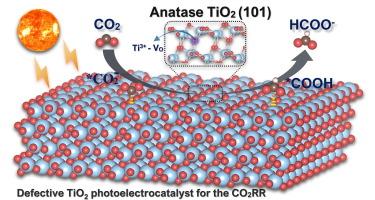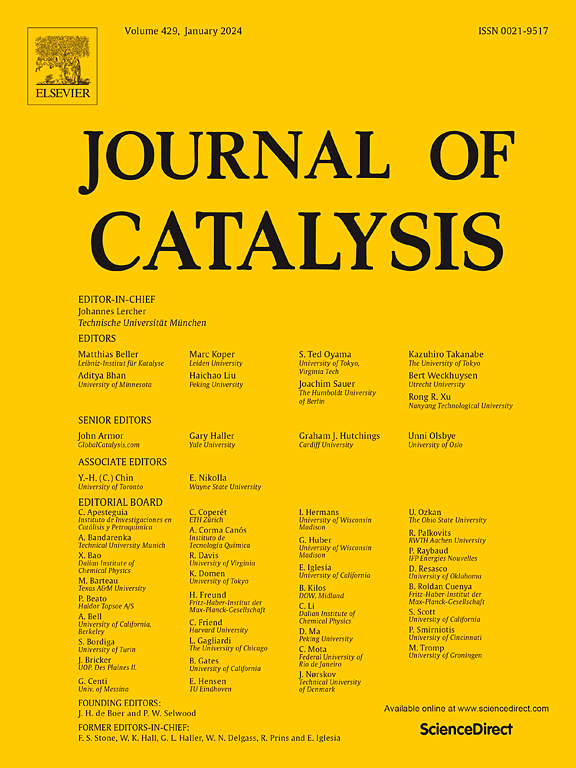Ultra-thin defective TiO2 films as photocathodes for selective CO2 reduction to formate
IF 6.5
1区 化学
Q2 CHEMISTRY, PHYSICAL
引用次数: 0
Abstract
Titanium dioxide (TiO2) has been widely used as a photocatalyst in CO2 reduction reaction (CO2RR) due to its low cost, high stability, and strong absorption in the close-to-visible ultra-violet (UV) range. However, TiO2 films suffer from poor selectivity in CO2 reduction due to their unfavorable electronic properties. In this work, we address this challenge by fabricating ultra-thin (14 nm) defective TiO2 films (TiO2-DTF) to enhance the selectivity of CO2RR towards formate.
TiO2 sol was prepared using a facile and reproducible sol-gel method and directly deposited onto the surface of the electrode, forming a uniform, ultra-thin TiO2 layers with a high number of defects. The activity of the TiO2-DTF catalyst was studied in both photochemical and photoelectrochemical CO2RR, indicating that the applied potential increases both the yield and selectivity of CO2RR to formate. The TiO2-DTF photocathode exhibited remarkable formate production during CO2 reduction, achieving exceptional Faradaic efficiencies of up to 45 %. To elucidate the mechanism of photoelectrochemical CO2RR on TiO2-DTF, an in-situ attenuated total reflection Fourier-transform infrared spectroscopy (in-situ ATR-FTIR) was used and experimental results were supported by density functional theory (DFT) calculations. This study demonstrates that ultra-thin highly defective TiO2 film, prepared using the cost-effective and environmentally friendly sol-gel method, can be used as photoelectrocatalyst for CO2 reduction.


超薄缺陷TiO2薄膜作为选择性CO2还原生成甲酸的光电阴极
二氧化钛(TiO2)具有成本低、稳定性高、近可见光吸收强等优点,在CO2还原反应(CO2RR)中被广泛用作光催化剂。然而,TiO2薄膜由于其不利的电子性能,导致其在CO2还原中的选择性较差。在这项工作中,我们通过制造超薄(14 nm)缺陷TiO2薄膜(TiO2- dtf)来提高CO2RR对甲酸盐的选择性来解决这一挑战。采用简单、可重复的溶胶-凝胶法制备TiO2溶胶,直接沉积在电极表面,形成均匀、超薄、缺陷多的TiO2层。研究了TiO2-DTF催化剂在光化学和光电化学CO2RR中的活性,表明施加电位提高了CO2RR的收率和甲酸选择性。TiO2-DTF光电阴极在CO2还原过程中表现出显著的甲酸生成,实现了高达45%的法拉第效率。为了阐明光电化学CO2RR对TiO2-DTF的作用机理,采用原位衰减全反射傅里叶变换红外光谱(原位ATR-FTIR),并通过密度泛函理论(DFT)计算支持实验结果。本研究表明,采用经济高效、环境友好的溶胶-凝胶法制备的超薄高缺陷TiO2薄膜可作为CO2还原的光电催化剂。
本文章由计算机程序翻译,如有差异,请以英文原文为准。
求助全文
约1分钟内获得全文
求助全文
来源期刊

Journal of Catalysis
工程技术-工程:化工
CiteScore
12.30
自引率
5.50%
发文量
447
审稿时长
31 days
期刊介绍:
The Journal of Catalysis publishes scholarly articles on both heterogeneous and homogeneous catalysis, covering a wide range of chemical transformations. These include various types of catalysis, such as those mediated by photons, plasmons, and electrons. The focus of the studies is to understand the relationship between catalytic function and the underlying chemical properties of surfaces and metal complexes.
The articles in the journal offer innovative concepts and explore the synthesis and kinetics of inorganic solids and homogeneous complexes. Furthermore, they discuss spectroscopic techniques for characterizing catalysts, investigate the interaction of probes and reacting species with catalysts, and employ theoretical methods.
The research presented in the journal should have direct relevance to the field of catalytic processes, addressing either fundamental aspects or applications of catalysis.
 求助内容:
求助内容: 应助结果提醒方式:
应助结果提醒方式:


